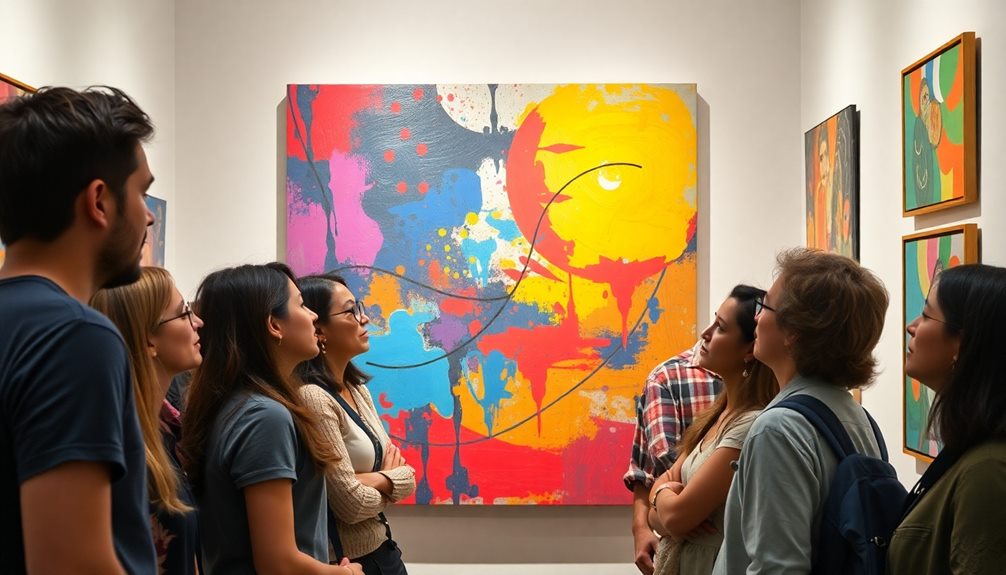Art interpretation helps you uncover the layers of meaning behind an artwork. It's about exploring the themes, cultural significance, and the artist's intentions. You'll realize that different viewers can derive varied meanings from the same piece, reflecting their unique experiences. To interpret art effectively, focus on its formal elements and ask essential questions: who, what, when, where, and why. Consider the context, including the artist's background and historical influences, to deepen your insights. Engaging with diverse opinions not only challenges your perceptions but also enriches your understanding. Continue on, and you'll uncover even more strategies to enhance your art interpretation skills.
Key Takeaways
- Art interpretation explores multiple meanings, influenced by viewers' backgrounds and experiences, with no single correct answer.
- The "Five W" questions (who, what, when, where, why) provide a structured approach for deeper analysis of artworks.
- Contextual understanding, including historical and cultural influences, enriches the interpretation and appreciation of art.
- Engaging in discussions fosters diverse perspectives, encouraging critical thinking and emotional connections with artworks.
- Emotional responses to art shape subjective interpretations, enhancing personal reflection and growth through individual experiences.
Introduction
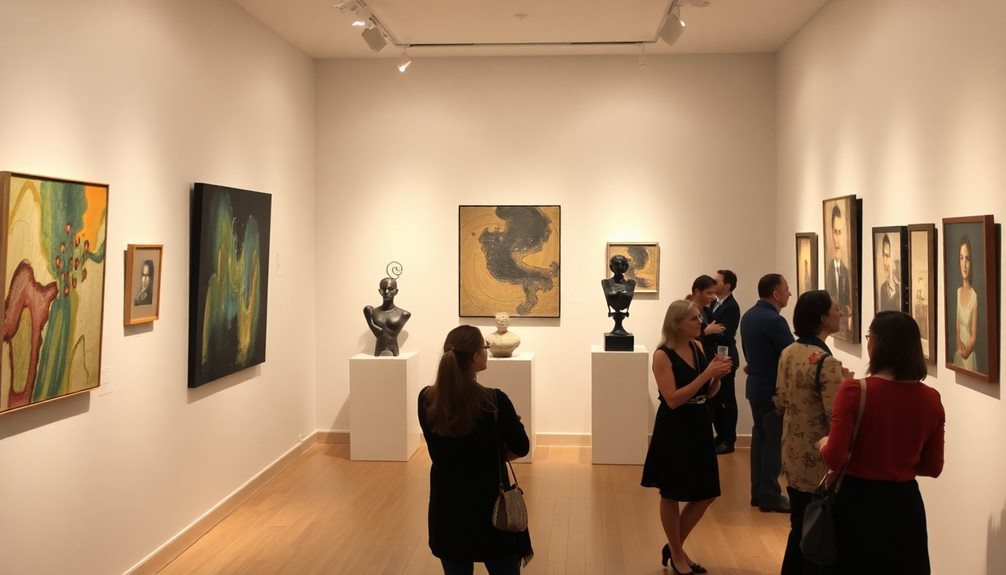
Art interpretation offers a fascinating journey through the layers of meaning found in various artworks. When you dive into art interpretation, you engage with the piece on a deeper level, exploring its themes, cultural significance, and the artist's intention.
This process isn't just about your personal feelings; it also involves recognizing how different viewers can derive vastly different meanings from the same artwork. To enhance your understanding of this process, consider how igniting creativity in a digital world can influence your perspective on art, as digital distractions often hinder our ability to connect deeply with creative expressions.
To truly appreciate what you see, contextual understanding is essential. This means considering the artist's background, the historical influences at play, and the cultural environment surrounding the artwork's creation.
Key Concepts and Definitions

Understanding key concepts and definitions in art interpretation is crucial for a deeper appreciation of any artwork. Art interpretation involves analyzing and assigning meaning to a piece, where you might find that different viewers arrive at diverse interpretations based on their backgrounds and perspectives.
While proper interpretations exist, remember there's no single correct answer; the meaning of the work can shift depending on context, personal experiences, and cultural significance. Engaging with different forms of expression, such as visual art or even practical tools like cleaning vacuum cleaners, can enhance your analytical skills and broaden your perspective.
To enhance your interpretation process, consider the "Five W" questions: who, what, when, where, and why. These questions serve as essential tools, guiding you in your analysis and helping you uncover layers of meaning within the artwork.
Contextual understanding, which includes historical, biographical, and genre-related information, plays a vital role in enriching your interpretation.
Engaging with an artwork through interpretation not only promotes emotional and intellectual connections but also encourages dialogue and debate among audiences regarding its meaning. By actively participating in this process, you deepen your appreciation and understanding of art, making the experience more fulfilling and enriching.
Art Interpretation Framework
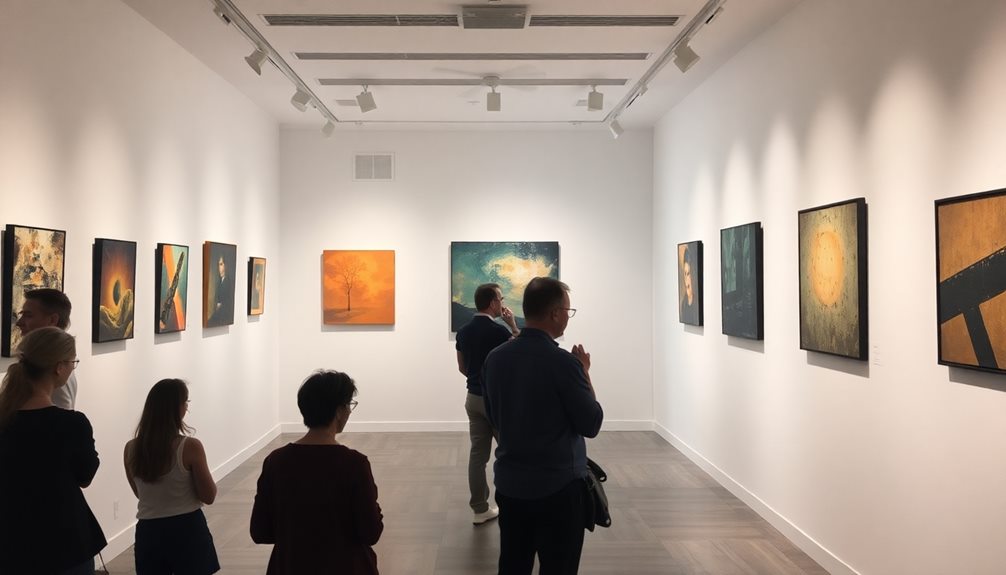
Interpreting artwork involves a structured framework that helps you analyze its various elements, such as subject matter, style, and context. Start by considering the artistic style, which can reveal the techniques and movements that influenced the artist. For example, you might explore how Polynesian symbols for strength convey resilience and cultural identity in certain pieces.
Next, delve into the subject matter—what the artwork depicts—and how it relates to the artist's intention. Ask yourself fundamental questions: Who created the work? When and where was it made? Why was it created? These questions guide your understanding and allow you to engage more deeply with the piece.
Don't forget the importance of context. The artist's background, historical events, and cultural movements can significantly shape the interpretation of the artwork. This is where the debate between intentionalism and anti-intentionalism comes into play. Should you focus solely on the artist's intention, or should you consider conventional meanings that evolve over time?
Ultimately, engaging in art interpretation fosters emotional and intellectual dialogue among viewers. It invites diverse perspectives, enriching your experience and understanding of the artwork. By applying this framework, you can appreciate the layers of meaning that art holds and connect with it on a deeper level.
Real-world Art Interpretation Instances
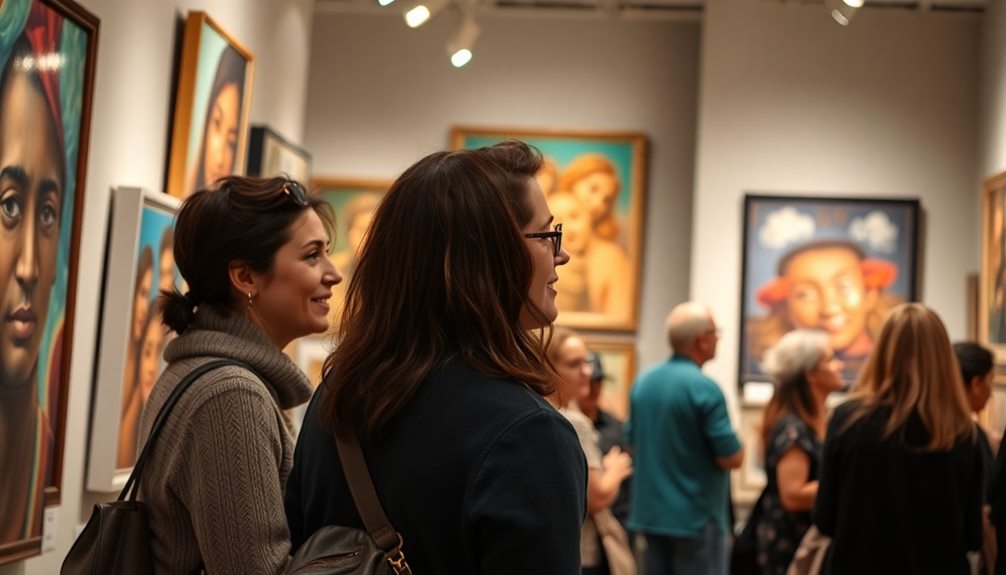
Real-world examples of art interpretation vividly illustrate how context shapes meaning and enriches our understanding.
Take Blondie's song "One Way or Another." When you grasp the band's experiences and the social environment during its creation, your perception of the work of art shifts significantly.
Similarly, Maya Angelou's poem "Still I Rise" resonates more deeply when you consider her life experiences, emphasizing themes of resilience and empowerment that echo her personal history.
Picasso's "Guernica" stands as a powerful response to the Spanish Civil War, showcasing the artist's intention to convey anti-war sentiments. The fragmented forms and monochromatic palette evoke a depressive mood that influences your emotional engagement, enhancing your understanding of the artwork's message.
Artistic movements, like Impressionism, also play a crucial role in interpreting art. By recognizing the historical and cultural contexts that shaped these artists' approaches, you gain insight into their themes and intentions.
Each of these instances highlights how historic events and personal backgrounds significantly alter your interpretation, showing that context is key in truly appreciating a work of art.
Tips and Best Practices
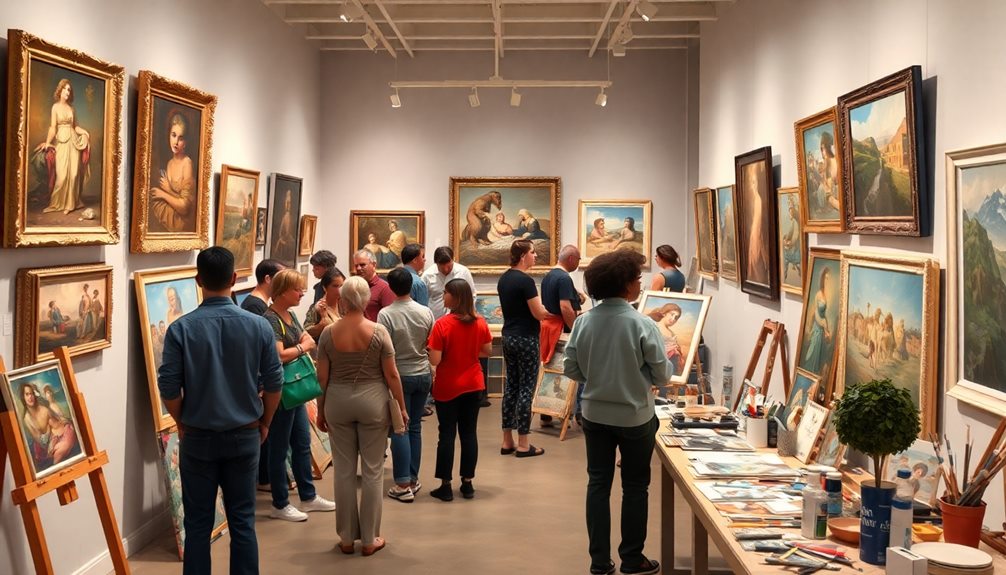
To effectively interpret art, start by closely observing its formal elements, like color, line, shape, and composition. These aspects are fundamental to understanding the work's overall impact and meaning.
Take your time to analyze how these elements interact and contribute to the piece's emotional resonance.
Next, utilize the Five W questions—who, what, when, where, and why—to deepen your contextual understanding. This approach helps you explore not just the artwork itself but also its background and significance.
Researching the artist's background and the historical context can reveal influences that shape the work.
Engaging in open-minded discussions with others is another best practice. Sharing different perspectives can greatly enhance your understanding and appreciation of the artwork.
Everyone brings unique insights that can illuminate aspects you might've overlooked.
Lastly, practice synthesizing your observations into a cohesive interpretation. Ensure your analysis is supported by evidence drawn from the formal elements and context of the work.
Audience Engagement and Feedback
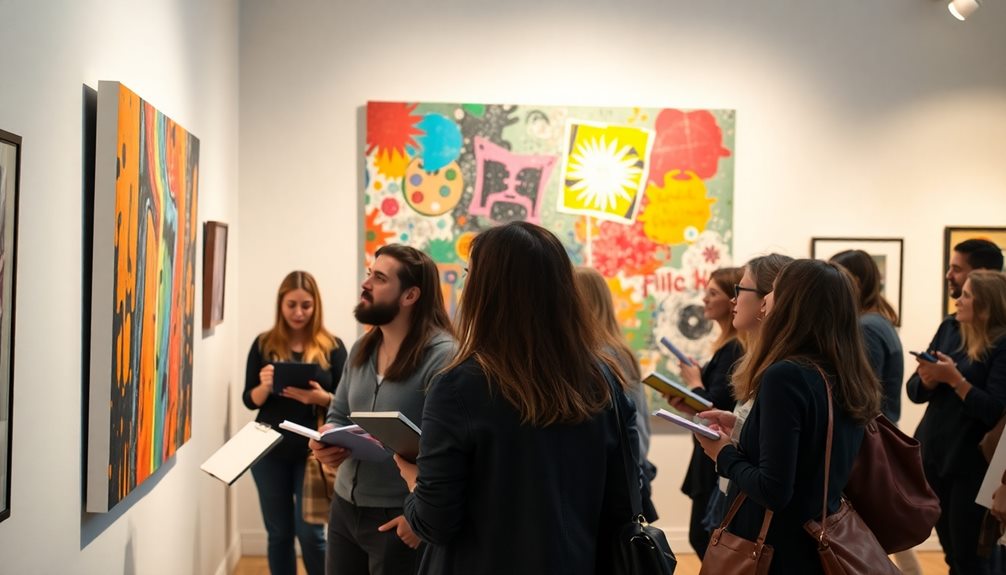
Art interpretation becomes even more enriching when you invite audience engagement and feedback into the conversation. Engaging your audience in dialogue encourages diverse perspectives, fostering a deeper understanding of individual interpretations.
By opening the floor to personal opinions, you create a space where different types of insights can flourish. Audience feedback can reveal powerful insights about emotional responses and personal connections to the artwork, enhancing the overall interpretative experience.
When you incorporate audience reactions into discussions, you facilitate richer analyses, as differing viewpoints challenge preconceived notions and stimulate critical thinking.
Interactive activities, like guided discussions or feedback sessions, help audiences articulate their interpretations and explore various meanings behind the artwork.
Understanding the demographic background of your audience is crucial, as personal experiences significantly influence how they perceive and interpret art.
Subjectivity in Interpretation

Every viewer approaches a piece of art with a unique lens shaped by their experiences, emotions, and cultural backgrounds. This subjectivity in interpretation means that each person extracts different meanings from the same artwork. There's no single correct interpretation; instead, multiple interpretations coexist, reflecting the rich tapestry of individual perspectives.
Your emotional responses—whether love, hate, or confusion—play a crucial role in shaping your subjective interpretations. These feelings can prompt you to dig deeper into the artwork's meaning, revealing layers you mightn't have considered at first. Engaging with diverse viewpoints enhances your understanding and appreciation of art, as differing opinions can challenge your own and expand your horizons.
Art isn't just a visual experience; it's a personal journey that allows you to form a wide array of insights and connections. By recognizing that everyone interprets a piece of art differently, you embrace the complexity of emotional responses and the richness of varied perspectives.
Additional Resources

While diving deeper into art interpretation, you might find a wealth of resources that can enhance your understanding and appreciation. Websites like Study.com offer over 30,000 video lessons, quizzes, and worksheets specifically designed to improve your analysis of works of art.
For those eager to learn about art history or explore biographical details of artists, free articles and resources are readily available online.
Additionally, various online platforms provide access to scholarly texts and case studies that delve into different theories and methodologies in art interpretation, including Performance Art. These resources can help you better grasp the context and significance behind various artistic movements.
Don't overlook the value of museums and galleries, which often host educational programs and workshops focused on interpreting specific artworks. Engaging in these hands-on experiences can deepen your insights.
Lastly, consider joining community art discussions or forums. Sharing perspectives with other art enthusiasts can enrich your understanding and provide new angles on art interpretation.
Frequently Asked Questions
How to Interpret Art for Beginners?
To interpret art as a beginner, focus on colors, shapes, and textures. Ask yourself who, what, when, where, and why. Discuss your thoughts with others to gain different perspectives and deepen your understanding.
What Is the Art of Interpretation?
The art of interpretation's about analyzing details and drawing personal meaning from a piece. You'll explore themes, emotions, and contexts, allowing you to connect deeply with the artwork and appreciate its layers more fully.
What Are the Methods of Art Interpretation?
You can interpret art by observing its formal elements like color and texture, analyzing the artist's style, researching the context, and asking the "Five W" questions to deepen your understanding of the artwork's meaning.
What Is the Interpretation Step in Art?
The interpretation step in art involves analyzing the artwork's elements and context to uncover meaning. You'll explore who created it, what it depicts, and the historical and emotional significance behind it, enhancing your understanding.
Conclusion
In conclusion, mastering art interpretation enriches your experience and deepens your understanding of creativity. By applying the key concepts and frameworks discussed, you can confidently analyze and appreciate various artworks. Don't forget to engage with others and embrace the subjectivity that comes with interpretation—it's what makes art personal and vibrant. So, grab a piece of art, dive in, and let your insights flow! Keep exploring and enjoy the journey of discovery!
